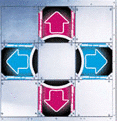当前你的浏览器版本过低,网站已在兼容模式下运行,兼容模式仅提供最小功能支持,网站样式可能显示不正常。
请尽快升级浏览器以体验网站在线编辑、在线运行等功能。
1726:Tango Tango Insurrection
Special Judge 特殊评判题目描述

 You are attempting to learn to play a simple arcade dancing game. The game has 4 arrows set into a pad: Up, Left, Down, Right. While a song plays, you watch arrows rise on a screen, and when they hit the top, you have to hit the corresponding arrows on the pad. There is no penalty for stepping on an arrow without need, but note that merely standing on an arrow does not activate it; you must actually tap it with your foot. Many sequences in the game are very fast-paced, and require proper footwork if you don't want to tire yourself out. Write a program to determine the easiest way to execute a certain sequence of arrows.
You are attempting to learn to play a simple arcade dancing game. The game has 4 arrows set into a pad: Up, Left, Down, Right. While a song plays, you watch arrows rise on a screen, and when they hit the top, you have to hit the corresponding arrows on the pad. There is no penalty for stepping on an arrow without need, but note that merely standing on an arrow does not activate it; you must actually tap it with your foot. Many sequences in the game are very fast-paced, and require proper footwork if you don't want to tire yourself out. Write a program to determine the easiest way to execute a certain sequence of arrows.
We will work with a basic time unit of an eighth-note. At any given time, your left foot and right foot will each be on distinct arrows. Only one foot may perform an action (changing arrows and/or tapping) during any time unit; jumping is not allowed. Also, you must remain facing forward in order to see the screen. This puts limitations on which feet you can use to hit which arrows. Finally, hitting two arrows in a row with the same foot ("double-tapping") is exhausting, because you can't shift your weight onto that foot. Ideally, you want to alternate feet all the way through a string of consecutive arrows.
Performing an action with a foot costs 1 unit of energy if it did NOT perform an action in the previous time unit. If it did, then it costs 3 units if it doesn't change arrows, 5 units if it moves to an adjacent arrow, and 7 units if it moves directly across the pad (between Up and Down, or Left and Right).
Under normal circumstances, you can't put your left foot on Right, or your right foot on Left. However, you CAN do a temporary "crossover": if your left foot is on Up or Down, you can twist your hips and put your right foot on Left - but until your right foot moves away, you can't move your left to a different arrow. (Imagine the tangle your legs would get into if you tried!) Similarly, you can cross your left foot over/behind your right.
输入解释
You will be given multiple arrow sequences to provide foot guides for. Every sequence consists of a line containing from 1 to 70 characters, representing the arrow that must be hit at each time unit. The possible characters are U, L, D, and R, signifying the four arrows, or a period, indicating that no arrow need be hit. Assume that your left and right feet start on the Left and Right arrows for the first time unit of a sequence.
There are at most 100 sequences. Input is terminated by a line consisting of a single #.
There are at most 100 sequences. Input is terminated by a line consisting of a single #.
输出解释
For each input sequence, output a string of the same length, indicating which foot should perform an action at each time step, or '.' if neither does. If there are multiple solutions that require minimal energy, any will do.
输入样例
LRLRLLLLRLRLRRRRLLRRLRLDU...D...UUUUDDDD #
输出样例
LRLRLLLLRLRLRRRRLLRRLRLRL...R...LLLLRRRR
最后修改于 2020-10-29T06:12:15+00:00 由爬虫自动更新
共提交 0 次
通过率 --%
| 时间上限 | 内存上限 |
| 1000 | 10000 |
登陆或注册以提交代码